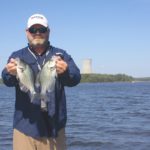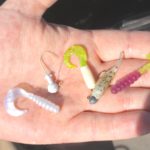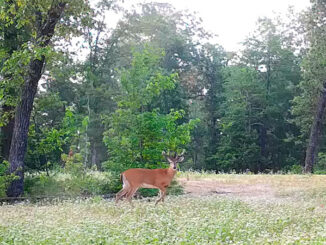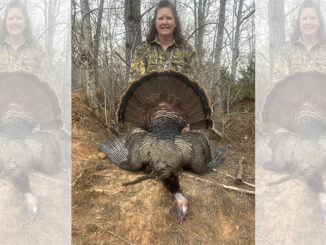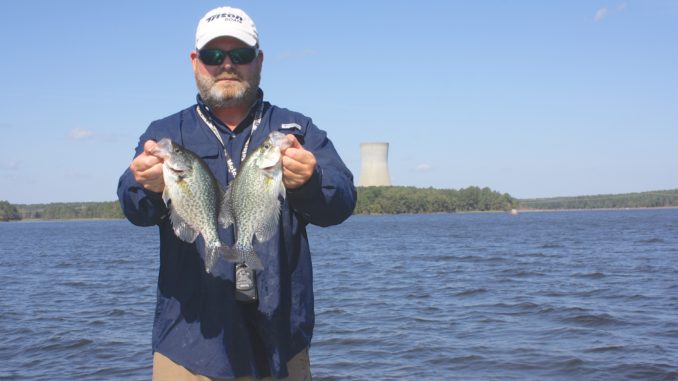
Crappie fishing at Shearon Harris Lake can be a great way to celebrate a day on the water this December. Here are some tips for catching the tasty panfish.
When most fishermen recall the day when they first started crappie fishing, typically involve nostalgic boyhood tales of bobbing with minnows with family members at a local pond or lake.
Guide Joel Munday of Outdoor Expeditions USA has memories of a more recent origin.
“I didn’t begin crappie fishing until about five years ago, and I mainly educated myself on how to catch them” he said.
Munday’s decision to learn about crappie fishing came from his job: guiding bass fishermen since the late 1990s on the three lakes that surround Raleigh, N.C.: Falls of Neuse, Jordan and Shearon Harris. Munday began getting numerous requests for guided crappie trips, so he started studying up on slabs.
“It was a matter of supply and demand that prompted me to guide for crappie,” he said. “It was also another way to supplement my earnings.”
With no prior crappie-fishing experience, Munday had a formidable task in becoming an “expert” on slabs.
“I couldn’t have done it without the new advances in electronics,” said Munday who uses wide-scan imaging units to locate crappie when they aren’t shallow and are more difficult to catch than in the spring.
Munday said crappie are similar to bass when spring gives way to summer. They move to offshore structure harboring stumps or brush, or they suspend in deep water near forage.
“If I had one tip to give crappie fishermen to help them increase their catches, it would be to invest in a quality electronics unit, one that offers good separation of images and GPS capabilities,” he said. “With my down-imaging feature, crappie look like Christmas bulbs on sticks where there are standing trees at Harris, and with my GPS, I can easily return to offshore places.”
Of the three Raleigh-area lakes, Munday likes Jordan and Harris for crappie fishing.
“Jordan gets the nod for bigger crappie, but the fish are not nearly as abundant as they are in Harris, which has plenty of crappie ranging from 8 to 12 inches (long),” he said.
Munday speculates regulations may account for some of the difference. Jordan has a 10-inch minimum size and a 20-fish daily creel limit, while there are no restrictions on crappie at Harris.
“We don’t think the crappie are being overharvested at Shearon Harris and don’t think we need a regulation at this time,” said Kirk Rundle, a fisheries biologist with the N.C. Wildlife Resources Commission. “We are seeing good catch rates, average growth rates with older fish in the population, and good relative weights.”
Munday divides December the into two periods, reflecting its transitional nature for crappie and based largely upon water temperature.
In early December, with the water temperature in the mid-50s, Munday looks for crappie on long, tapering or flat, main-lake points in 12 to 20 feet of water.
He starts fishing the shallow ends of those spots, then moves deeper to their break lines. Finding brush or stumps is a bonus.
“Harris is loaded with brush piles deposited by local fishermen,” Munday said. “I’ve spent considerable time motoring about and marking brush.”
To catch crappie, Munday uses a medium-light 13 Fishing Omen spinning rod and 13 Fishing Creed GT spinning reel.
“The reel has a 6.2-to-1 gear ratio for a quick line pick-up,” he said.
If crappie are schooled on points, Munday positions his boat a few yards away and has his clients cast over the school so they can retrieve 1/8- or 1/32-ounce crappie jigs through the school.
Harris is usually clear, so water color is not the primary factor in choosing jig colors. Munday selects natural-looking pearl jigs with pink or blue hues to match the lake’s threadfin shad or chooses John Deer green or chartreuse to provide a sharp contrast. Then, he lets fish tell him which colors they prefer on a given day.
If he finds brush, standing timber or other cover on a point, he spools up with 15-pound PowerPro braid with a 3- to 4-foot lealder of 12-pound Seaguar fluorocarbon.
“That combination is extremely sensitive and has virtually no stretch,” Munday said. “It is also very strong and allows you to straighten out the hook on a hung jig so you lose less tackle.”
He connects the main line to the leader with a double uni-knot.
“The double uni-knot is important because it runs through the rod guides without getting hung, it’s easy to tie and it’s excellent for connecting braided line to fluorocarbon line,” Munday said.
If the fish are scattered on the point, he trolls with three or four lures at different depths out of the boat’s stern. If the fish are stacked on the point in brush or other cover, Munday resorts to a vertical presentation, positioning his boat over the fish and having his clients lower crappie jigs or live minnows into the cover.
“It’s like video-game fishing,” said Munday, who ties a No. 1/0 Aberdeen dropper hook, running the barb through the back of the minnow or between its eyes.
“The different hook arrangements give the minnows a different action,” said Munday. “I rarely tip my jigs with minnows, though that’s a common practice for tournament crappie fishermen after big crappie. For me, it’s more of a numbers game to please my clients, many of whom have limited fishing experience and just want to catch fish.”
Other places to look in early December includes the abandoned railroad trestle that runs across a good portion of the lake and is depicted on most maps.
“The trestle is a community fishing hole that’s dotted with brush piles,” Munday said. “It’s mainly productive in early December when the fish are in the 15- to 17-foot range.”
Finally, some of the long points at Harris hold standing timber. Whiles these underwater forests attract crappie, Munday said they’re troublesome to fish because of snagged lines and baits.
“You don’t want inexperienced clients fishing for crappie in a bunch of trees; they’ll get frustrated snagging their baits,” he said.
Instead, he prefers points with isolated brush or stumps where numbers of fish gather and where hang-ups can be kept to a minimum.
Munday changes tactics laster in December when water temperatures dip below 50 degrees. He does most of his fishing on the lower end of the lake, where crappie frequently suspend in 25 to 30 feet of water around main-lake points or large masses of forage.
“This year, there’s been a notable increase in the numbers of threadfin shad, and by late December, most of them move to the lower end of the lake,” said Munday, who slow-trolls using his trolling motor for these suspended fish, mounting four rods from the stern and transom so they are readily visible should a strike occur and easily accessible to his clients.
He staggers the baits, either jigs or minnows, at various depths in the anticipated strike zone based upon his electronics.
When trolling, he uses 8- to 10-pound test Suffix or Trilene monofilament or fluorocarbon without leaders.
Should conditions dictate a vertical presentation, he moves rods to the boat’s bow where they can be lowered into concentrations of fish.
Other late-December strategies include slow-trolling parallel to steep, bluff walls or targeting crappie suspended around deep tree laps.
Munday said the ideal day for December crappie fishing would be one with little wind, stable weather and clear to slightly cloudy skies. Conversely, fishermen would be wise to stay home on a day with strong winds, days following cold snaps and dreary days.
Three other factors — current, water level and water color — play only minor roles at Harris.
“There’s only one small area of the lake that’s influenced by current, and that’s a well-known spot on the dam side of the lake where the power plant releases water into the lake” Munday said. “There is almost always some current there, and at certain times of the year it is obvious and visible. The more current, the more fish and the better the bite. The released water is not heated. The plant also releases (treated) sewage into the lake through the pipe. Shad, crappie, and other species will get in and around the area where the current is and suspend there.”
Munday said Harris rarely fluctuates, and the water is usually clear.
Munday said on a half-day trip in early December, his clients usually catch 20 to 25 fish, most from 8 to 14 inches long. There are magical, 100-fish days, but late December is less predictable because of weather changes. A quality crappie at Harris weighs 11/2 pounds.
Whether you’re a novice or a seasoned crappie fisherman, don’t pass up the exciting winter action for crappie at Shearon Harris throughout December.
DESTINATION INFORMATION
HOW TO GET THERE — Shearon Harris Lake is southwest of Raleigh, just off US 1, in Wake and Chatham counties. Two major boat landings serve the lake: Holleman’s Crossing, off SR 1130, (Holleman Road) two miles from the SR 1127/1130 intersection, and Merry Oaks, close to the dam off SR 1914, less than a mile from NC 42.
WHEN TO GO — Spring fishing as great, but the fall period from mid-October through December can also be excellent for crappie.
BEST TECHNIQUES — In early December, with the surface water temperatures in the mid-50s, crappie will be in 12 to 20 feet of water off long, tapering points, especially those with brush piles. Fish can be taken by casting or vertically jigging crappie jigs or lowering live bait into cover. Later in the month, with water temperatures in the 40s, fish will move and suspend with forage in 25 to 30 feet of water. Slow-trolling with live bait and or/jigs becomes more effective.
FISHING INFO/GUIDES — Joel Munday, Outdoor Expeditions Guide Service, 919-669-2959, www.outdoorexpeditionsusa.com; Freddie Sinclair, Sinclair’s Guide Service, afreddie@sinclairsguideservice.com. See also “Guides and Charters” in classifieds.
ACCOMMODATIONS — The closest motels are in Sanford; Econo Lodge, 919-774-6411; Hampton Inn, 919-775-2000; Days Inn, 919-776-3150; Baymont Suites, 919-776-3150.
MAPS — Kingfisher Maps, 800-326-0257, www.kfmaps.com; Harris Visitors Center, 919-362-3261.

